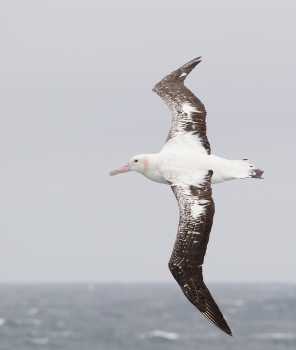Sebastian Jiménez (Laboratorio de Recursos Pelágicos, Dirección Nacional de Recursos Acuáticos, Montevideo, Uruguay) and colleagues have published in the journal Animal Conservation on differences in survival rates between male and female Wandering Albatrosses Diomedea exulans.
The paper’s abstract follows:
“The population of wandering albatrosses Diomedea exulans at South Georgia is decreasing because of bycatch in longline fisheries. Until at least the early 1990s, the survival rate of females was lower than males, consistent with the adult female-biased bycatch reported for fisheries operating around the Brazil-Falklands Confluence (BFC). Here we use extensive tracking data (1990–2012) from breeding birds at South Georgia to investigate overlap with longline fishing effort reported to the International Commission for the Conservation of Atlantic Tunas (ICCAT). Using data from multiple years, we conclude that breeding females are at higher risk than males from all the main pelagic longline fleets in the south-west Atlantic. Our overlap index (based on fishing effort and bird distributions) correlated positively with numbers of ringed birds reported dead on longliners, indicating that the metric was a good proxy of bycatch risk. The consistent sex bias in overlap across years, and the likely resulting sex-biased mortality, could account for lower adult female survival rate at the colony. The risk from fisheries changed seasonally; both sexes overlapped with pelagic longline effort during incubation (January–March), and particularly during post-brood chick-rearing (May–December), whereas overlap was negligible during brooding (April). The highest percentage of overlap was with the Taiwanese fleet, then vessels flagged to Brazil, Uruguay, Spain, Japan and Portugal. Females were consistently at greatest risk in the BFC region, whereas males showed lower and more variable levels of overlap with fisheries from 35 to 45°S. Our results have important implications for management of ICCAT longline fisheries and conservation of this highly threatened albatross population.”

Wandering Albatross at sea in the South Atlantic, photograph by John Chardine
Reference:
Jiménez, S., Domingo, A., Brazeiro, A., Defeo, O., Wood, A.G., Froy, H., Xavier, J.C. & Phillips, R.A. 2015. Sex-related variation in the vulnerability of wandering albatrosses to pelagic longline fleets. Animal Conservation DOI: 10.1111/acv.12245.
John Cooper, ACAP Information Officer, 06 November 2015

 English
English  Français
Français  Español
Español